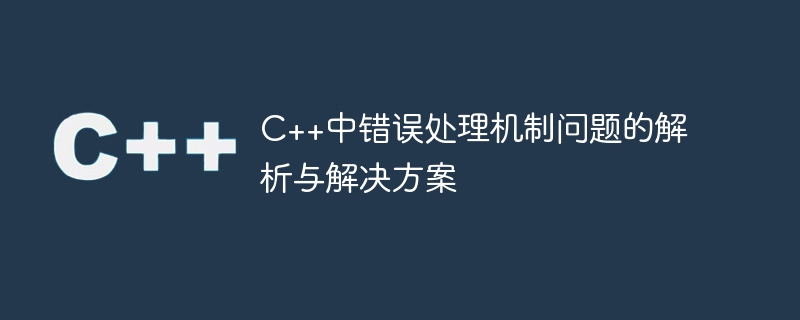Home >Backend Development >C++ >Analysis and solutions to error handling mechanism problems in C++
Analysis and solutions to error handling mechanism problems in C++
- 王林Original
- 2023-10-08 10:15:211462browse

Analysis and solution of error handling mechanism problems in C
Introduction:
In software development, error handling is a very important part. When we write C programs, we will inevitably encounter various errors, including runtime errors and logic errors. To ensure program stability and reliability, we need to handle these errors correctly and provide appropriate solutions. This article will analyze the error handling mechanism in C and provide some solutions, accompanied by specific code examples to help readers better understand and apply.
1. Exception handling mechanism in C
The exception handling mechanism in C is implemented by using try-catch blocks. The code in the try block is regarded as a normally executed code block. If an exception occurs during execution, the remaining code in the try block will be skipped and the catch block will be entered for corresponding exception handling operations.
The following is a simple code example:
#include <iostream>
int main() {
try {
throw 10;
} catch (int e) {
std::cout << "捕获到异常,异常码为:" << e << std::endl;
}
return 0;
}In the above code, we throw an exception through the throw statement (an integer type exception is thrown here). In the try block, when the throw statement is executed, the program will immediately jump to the corresponding catch block to handle the exception and output the corresponding exception code. In this example, the program will output "Exception caught, exception code: 10".
2. Common runtime errors and their solutions
- Null pointer exception
Null pointer exception means that when we try to access a null pointer, it causes the program to crash. A common solution to this type of problem is to use a conditional statement to check if the pointer is null to avoid abnormal termination of the program.
The following is a sample code:
#include <iostream>
void func(int* ptr) {
if (ptr != nullptr) {
// 执行相应操作
} else {
std::cout << "指针为空!" << std::endl;
}
}
int main() {
int* p = nullptr;
func(p);
return 0;
}In the above code, we perform pointer judgment in the func function. When the pointer is null, output "The pointer is null!" prompt information, thus avoiding the occurrence of null pointer exception.
- Array out-of-bounds error
Array out-of-bounds error refers to an error caused when we try to access an array beyond its bounds. In order to avoid this error, we should always ensure that the index is legal when accessing the array.
The following is a sample code:
#include <iostream>
int main() {
int arr[5] = {1, 2, 3, 4, 5};
int index = 6;
if (index >= 0 && index < 5) {
std::cout << "数组中的值为:" << arr[index] << std::endl;
} else {
std::cout << "索引越界!" << std::endl;
}
return 0;
}In the above code, before accessing the array elements, we first determine the legality of the index, and only access it within the legal range operation to avoid array out-of-bounds errors.
3. Use of custom exception classes
In addition to using the built-in exception classes, we can also customize exception classes according to actual needs to better handle and manage exceptions.
The following is a sample code of a custom exception class:
#include <iostream>
#include <exception>
class MyException : public std::exception {
public:
MyException(const char* msg): m_msg(msg) {}
virtual const char* what() const throw() {
return m_msg;
}
private:
const char* m_msg;
};
int main() {
try {
throw MyException("自定义异常");
} catch (const std::exception& ex) {
std::cout << "捕获到异常,异常信息为:" << ex.what() << std::endl;
}
return 0;
}In the above code, we define a custom exception class MyException and implement the what() method in it, using to return exception information. In the main function, we throw an exception of type MyException and capture and output the exception information in the catch block.
Conclusion:
Through the above analysis, we understand the exception handling mechanism in C and provide solutions to some common runtime errors. At the same time, we also learned how to customize exception classes to better handle and manage exceptions. In actual software development, we should flexibly use exception handling mechanisms according to specific situations to improve the robustness and maintainability of the program.
References:
- https://en.cppreference.com/w/cpp/language/try_catch
- https://www.geeksforgeeks.org /exceptions-in-c/
The above is the detailed content of Analysis and solutions to error handling mechanism problems in C++. For more information, please follow other related articles on the PHP Chinese website!

